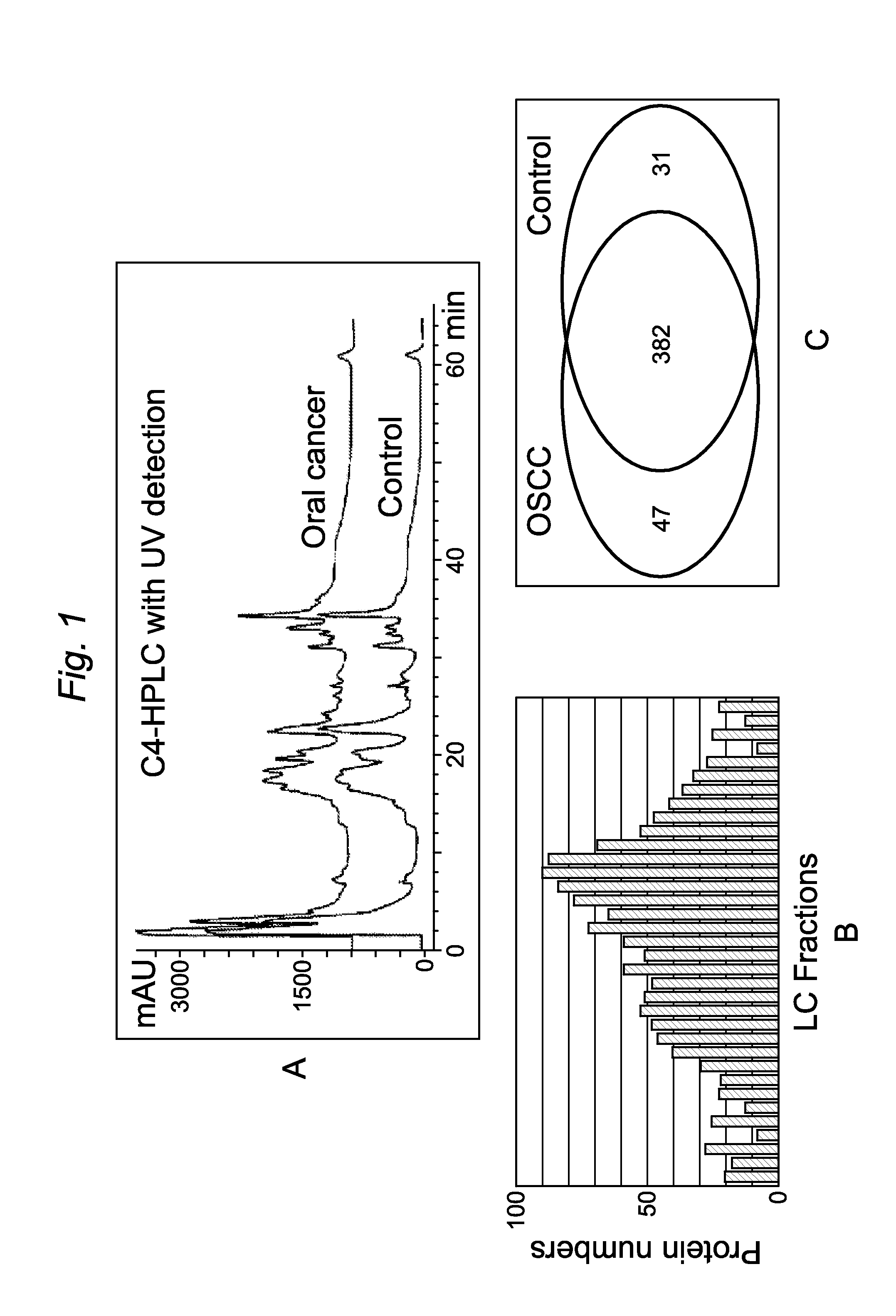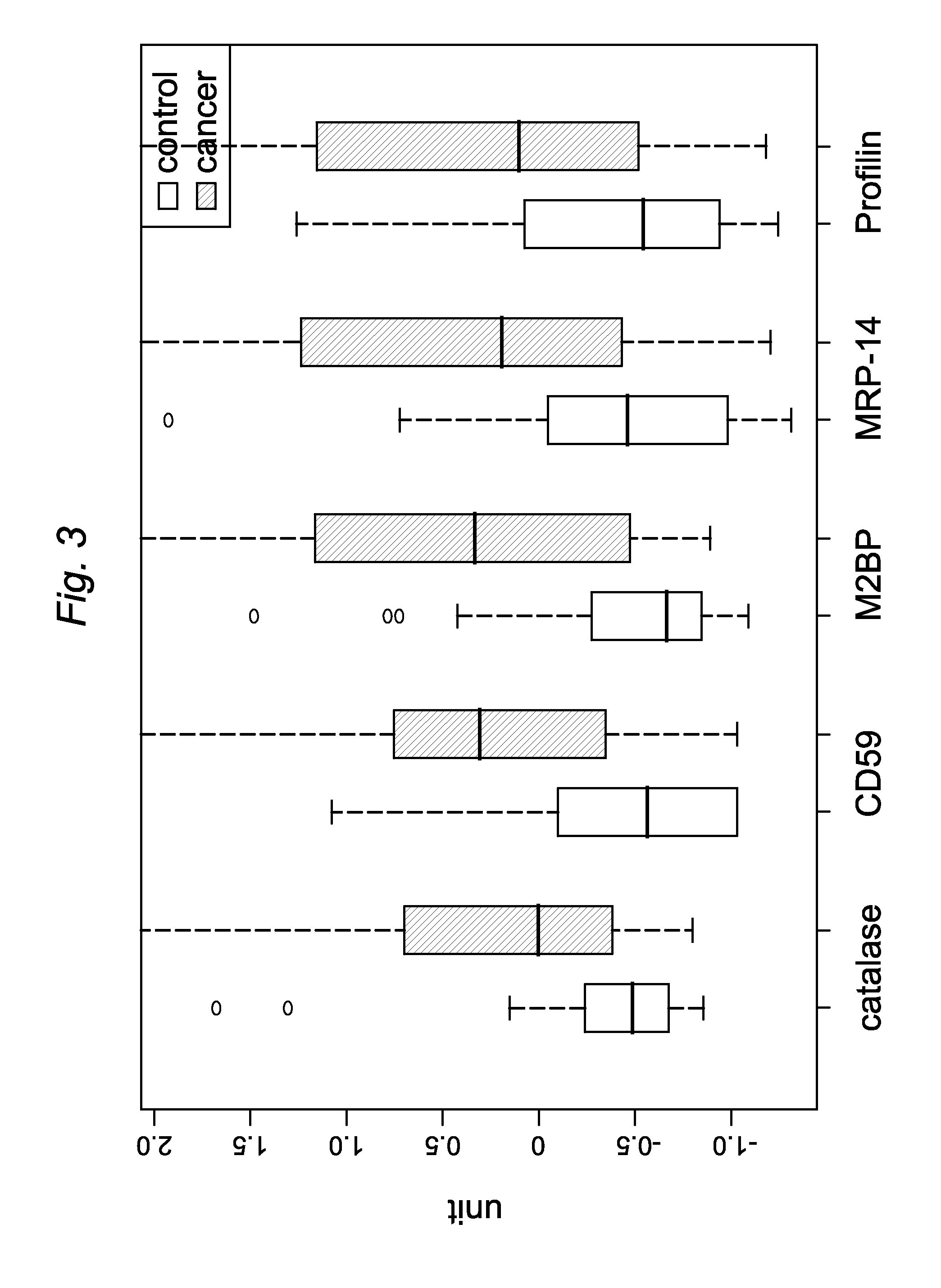Salivary protein biomarkers for human oral cancer
a saliva protein and oral cancer technology, applied in the field of saliva protein biomarkers for human oral cancer, can solve the problems of poor prognosis and survival, no reliable saliva biomarkers in the clinic, postoperative defects and functional impairments in patients,
- Summary
- Abstract
- Description
- Claims
- Application Information
AI Technical Summary
Benefits of technology
Problems solved by technology
Method used
Image
Examples
example 2
Patient Selection
[0144]All participants in this study signed the University of California-Los Angeles Institutional Review Board-approved consent form agreeing to donate saliva for experiments. All patients received diagnoses of OSCC and had no prior treatment in the form of chemotherapy, radiotherapy, surgery, or alternative medicine. Healthy control subjects were also recruited and matched for gender, age, smoking history and ethnicity. No patients had a history of prior malignancy, immunodeficiency, autoimmune disorders, hepatitis or HIV infection.
Saliva Collection
[0145]Unstimulated whole saliva samples were collected between 9 a.m. and 10 a.m. Patients were asked to refrain from eating, drinking, smoking, and oral hygiene procedures for at least 1 hour before saliva collection. Protease inhibitor cocktail (1 μl / ml aprotonin, 10 mg / ml PMSF, 400 mM sodium orthovanadate, Sigma-Aldrich, St. Louis, Mo., USA) were added immediately after sample collection in order to minimize protein ...
example 3
[0160]This example demonstrates that the differential expression of IL-8 in saliva is diagnostic of both OSCC and advanced periodontitis. Further, this example shows that the level of IL-8 or IL-8 mRNA can discriminate between OSCC and advanced periodontitis.
[0161]To date, two salivary proteins, IL8 and thioredoxin, are known to discriminate between the saliva from patients with oral cancer and the saliva from control subjects. IL8 was discovered through our previous tissue based expression profiling effort. IL8 is significantly elevated in saliva of oral cancer patients and is highly discriminatory of detecting oral cancer in saliva (n=64) with an ROC (receiver operator characteristic) value of 0.95, sensitivity 86% and specificity 97% at cutoff of 600 pg / ml (Alevizos et al., Oncogene, 20(43):6196-204 (2001); St. John et al., Arch Otolaryngol Head Neck Surg; 130:929-35 (2004)). Of interest, both IL8 protein and RNA are concordantly increased (St. John et al., Arch Otolaryngol Head ...
PUM
| Property | Measurement | Unit |
|---|---|---|
| Tm | aaaaa | aaaaa |
| temperatures | aaaaa | aaaaa |
| temperatures | aaaaa | aaaaa |
Abstract
Description
Claims
Application Information
 Login to View More
Login to View More - R&D
- Intellectual Property
- Life Sciences
- Materials
- Tech Scout
- Unparalleled Data Quality
- Higher Quality Content
- 60% Fewer Hallucinations
Browse by: Latest US Patents, China's latest patents, Technical Efficacy Thesaurus, Application Domain, Technology Topic, Popular Technical Reports.
© 2025 PatSnap. All rights reserved.Legal|Privacy policy|Modern Slavery Act Transparency Statement|Sitemap|About US| Contact US: help@patsnap.com



